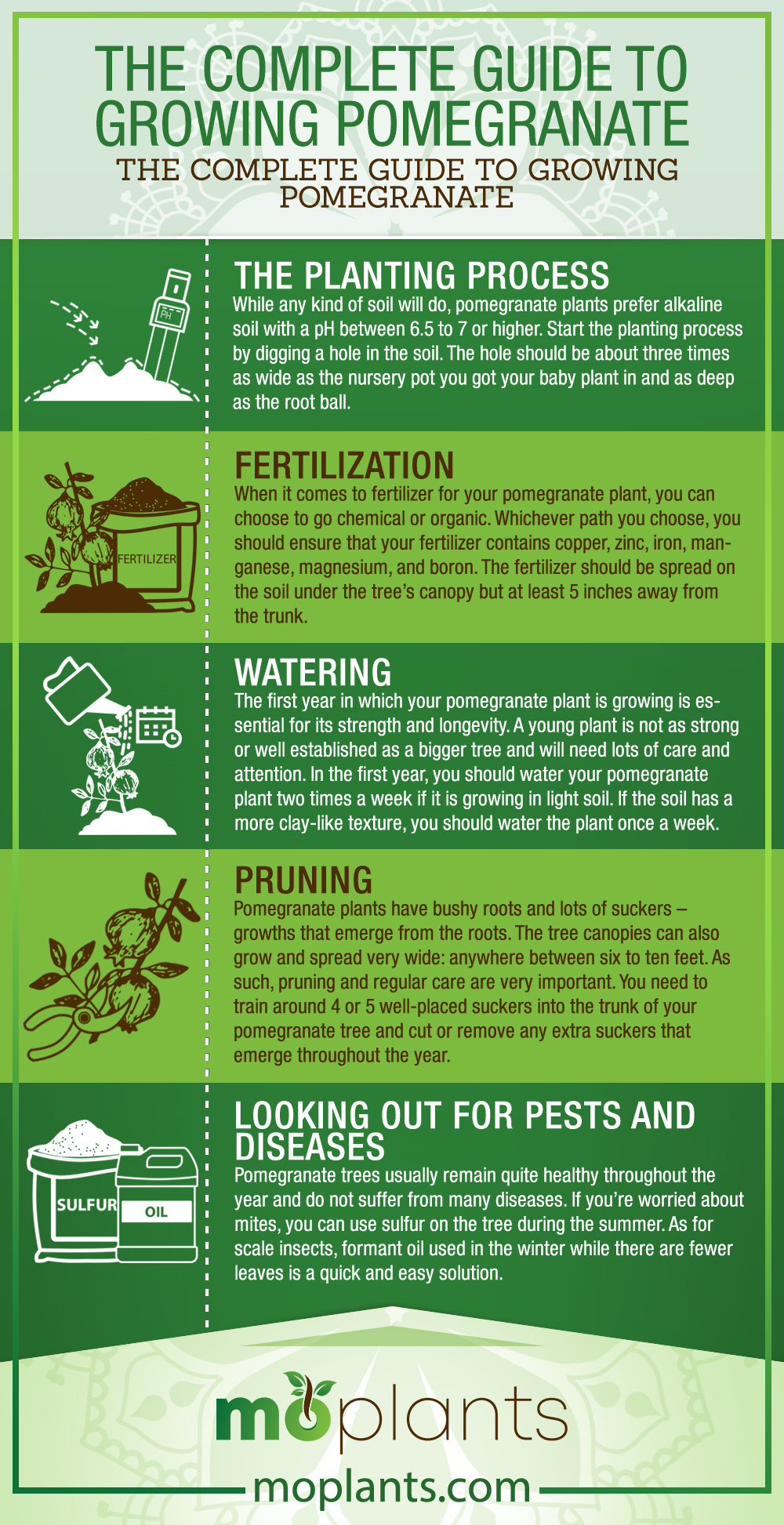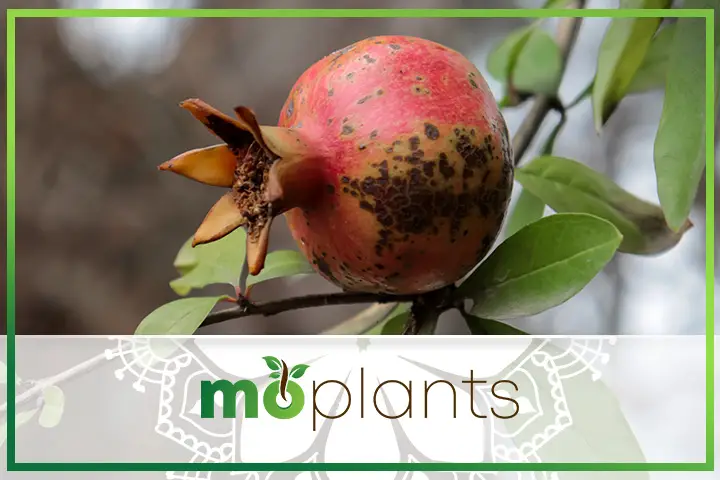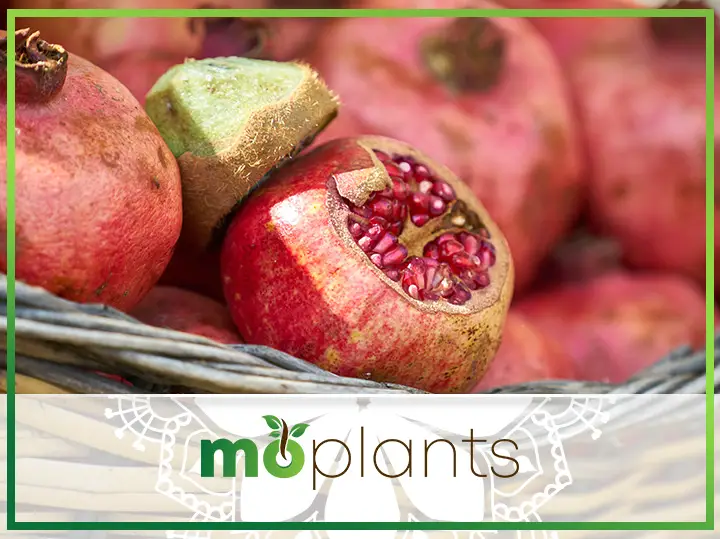If you’ve ever had the pleasure of eating pomegranate seeds, you’ll know just how delicious, juicy, and refreshing pomegranate can be. As someone who loves pomegranates and enjoys gardening, you should definitely consider growing pomegranate plants at home.
Not only will you be able to benefit from having home-grown pomegranate to eat whenever you like, but pomegranate trees can grow into full, rounded trees up to sixteen feet tall. These trees can be a wonderful addition to any home garden and also have beautiful red and orange blossoms growing in the first few years.
If you find yourself interested in growing pomegranates at home, read ahead to find out more about what type of pomegranate you should choose, a full pomegranate growing guide, and a few FAQs related to pomegranate growing.
What Type of Pomegranate You Should Plant
Pomegranates have been cultivated in different parts of the world for the last couple of centuries. As such, there are over 500 different types of pomegranates. The different types of pomegranate plants yield slightly different variations of the fruit. Some produce sweeter fruit, others alter the shells’ thickness and color, and others change the speed at which the fruits grow and ripen.
If you’re planning on growing pomegranates at home, here are some of the types you should consider growing. When choosing a type of pomegranate, keep in mind the growing conditions they require, the type of climate you experience, and whether you want to choose a dwarf plant or a larger tree.
Eversweet
Eversweet is a great variety to grow at home in cooler regions. This is because the eversweet produces pomegranates that are sweet and flavorful. Even if the pomegranates do not fully ripen, the fruits still have a sweet taste that you can enjoy. You can expect plenty of fruit in the spring and summer, with a harvest ready in August. The eversweet pomegranates are pink to light red and have small seeds. The tree can grow up to 12 feet high and between 6 to 8 feet wide, making it suitable for containers or open spaces alike.
Purple Heart
The purple heart is suitable for regions that remain warm throughout the year. The tree can tolerate below-freezing temperatures, but the fruit itself may not ripen enough if temperatures go below 20 °F. In warm temperatures, the fruit is ready for harvest in October. The purple heart is one of the larger pomegranate varieties, with trees growing up to 20 feet tall. The fruit is dark red with seeds that taste similar to the wonderful variety but less acidic.
Wonderful
Wonderful is the variety of pomegranates you would find most commonly in supermarkets and grocery stores. The large wonderful trees produce plenty of fruit during the spring and summer, and the harvest is ready in September. The fruits are a dark red with sweet, tart, and berry-tasting seeds. The wonderful can grow up to 10 to 15 feet in height and spread between 6 to 10 feet wide. It can also be grown in a contained space but would require lots of pruning and shaping.
Red Silk
If you have a small garden space or are looking to grow pomegranates in a container, the red silk variety is a good choice for you. The red silk pomegranate is a dwarf tree that reaches a maximum of 8 feet in height. Despite its small size, the red silk produces plenty of fruit that are ready to harvest in August.
The Complete Guide to Growing Pomegranate
Now that you have an idea of which type of pomegranate you want to plant, you can start growing your own pomegranate plant. Before you start, you should find the right spot in your garden. Pomegranates usually need lots of sun in order to grow well and produce plenty of fruits. Look for a spot that gets up to 6 hours of sunlight. As for the soil, you need good drainage, but any kind of soil will likely work. If you’re growing pomegranates in cooler temperatures, consider growing them in a container that can be moved later on when the temperature gets too cold.
Let’s go ahead and look at a more detailed pomegranate growing guide that will tell you everything you need to know, from prep and planting work to how to water, fertilize, and protect your pomegranate plant.
The Planting Process
While any kind of soil will do, pomegranate plants prefer alkaline soil with a pH between 6.5 to 7 or higher. Start the planting process by digging a hole in the soil. The hole should be about three times as wide as the nursery pot you got your baby plant in and as deep as the root ball. Remove your baby plant from its pot, loosen up the root ball, and gently place it into the hole. Pack the plant into place using the soil you originally removed from the hole mixed in with manure or compost. Give the plant lots of water to help the roots settle and get rid of air pockets in the soil. Remember to avoid adding fertilizer at this point since fertilization needs to be done at the right time of the year.
Fertilization
When it comes to fertilizer for your pomegranate plant, you can choose to go chemical or organic. Whichever path you choose, you should ensure that your fertilizer contains copper, zinc, iron, manganese, magnesium, and boron. The fertilizer should be spread on the soil under the tree’s canopy but at least 5 inches away from the trunk. In general, you want to fertilize around three times a year. You should avoid fertilizing after August, as this is usually the harvest time for most pomegranate plants. If you do fertilize after August, you can risk promoting later growth that might freeze over in colder temperatures, resulting in damage to the tree.
Watering
The first year in which your pomegranate plant is growing is essential for its strength and longevity. A young plant is not as strong or well established as a bigger tree and will need lots of care and attention. In the first year, you should water your pomegranate plant two times a week if it is growing in light soil. If the soil has a more clay-like texture, you should water the plant once a week. You should give the plant at least one inch of water and ensure that the whole root system of the plant is soaked. Make sure to keep up watering during any dry spells, or you can risk the pomegranate fruit dropping prematurely and not ripening correctly.
Pruning
Pomegranate plants have bushy roots and lots of suckers – growths that emerge from the roots. The tree canopies can also grow and spread very wide: anywhere between six to ten feet. As such, pruning and regular care are very important. You need to train around 4 or 5 well-placed suckers into the trunk of your pomegranate tree and cut or remove any extra suckers that emerge throughout the year. Once those few selected suckers grow into older wood, they can form a trunk that will support the growth and production of more fruit. As for pruning the canopy, you need to prune it every spring to remove frozen, damaged, or dead leaves and branches from the winter. And finally, thin out the number of fruit growing on the branches. Stick to one fruit every 6 inches so that the branches do not get damaged from the excessive weight of too many fruits and so that every fruit that remains can grow large and healthy.
Looking Out for Pests and Diseases
Pomegranate trees usually remain quite healthy throughout the year and do not suffer from many diseases. If you’re worried about mites, you can use sulfur on the tree during the summer. As for scale insects, formant oil used in the winter while there are fewer leaves is a quick and easy solution. Lastly, if you’re worried about leaf spots, you can spray the tree with a neutral copper spray.
Infographic


FAQs
Is my pomegranate tree dead if it does not grow leaves in spring?
If your pomegranate tree does not start to regrow the leaves it lost during the winter, do not worry. The tree is likely not dead and needs some time to recuperate. In case you had low temperatures below 10°F, the tree could have frost damage. In that case, try removing dead branches and wood. Once you’ve done this and the tree has had plenty of time to adjust to the warmer temperature, you can expect many leaves and blossoms.
Why does my pomegranate tree have lots of blossoms without any fruit?
A pomegranate tree does not immediately start growing fruit. It is common for a tree to yield its first fruits up to three years after it has been planted. The more mature a tree is, the more fruit it will yield. If your young pomegranate plant has plenty of blossoms but no fruit, or if the fruit continues to drop prematurely and does not ripen, don’t worry. Once your tree is older, you can expect more fruit.
In case your pomegranate tree is older and still only producing blossoms and not fruit, you may be over watering it, or there may be poor drainage, too much fertilizer, not enough sun, or any other adverse growing condition.
When is my pomegranate plant ready for harvesting?
The harvest time for different types of pomegranates and different varieties varies. Usually, the harvest period can be anywhere from early August all the way to November. If you’re not sure when your specific variety of pomegranate is ready to harvest, there are a few ways to tell if the fruit is ready. Check to see if the pomegranate fruit is the right color, its rind is the right texture, and the shape of the pomegranate is more hexagonal. Additionally, the fruit’s stem will start to get flatter, and the shell will become less shiny and rougher.
If you’re still unsure whether the fruit is ready to eat, cut one off and try it! Additionally, once the fruit is ripe, it will begin to fall from the tree, letting you know it is harvesting time.
Why are my pomegranate fruits splitting?
Splitting is when the pomegranate fruit still attached to the branches begins to split open so that the inside seeds are visible. This happens when the fruit has ripened and is ready to harvest but is left up on the branches too long. Changes in the soil’s moisture levels can also lead to splitting, as well as nearly-ripe fruit coming in contact with water.
Why are some of the pomegranate fruit from the harvest rotten on the inside?
Pomegranates are vulnerable to two kinds of plant rot: Alternaria and Aspergillus fruit rot. Both of these cause fruit to start rotting from the inside when fungus begins to grow in the fruit after rain. Old fruit that is left on the tree for too long can also be more susceptible to fungus, or it can split and make room for bacteria and fungus to enter the inside and cause rotting.
The Bottom Line
Growing a whole pomegranate tree at home can sound like a very overwhelming and difficult process, but try not to be discouraged. With over 500 varieties to choose from, you can easily find a type of pomegranate that will grow well in your garden’s conditions, regardless of how cold it gets, the kind of soil you have, and how much sunlight you get. You can even grow bigger pomegranate trees or smaller dwarf plants, depending on how much space you have. With lots of time and patience, you can grow a healthy and happy pomegranate plant that will give you lots of delicious and sweet fruit. Follow the growing guide above, and you’ll be sure to have the perfect pomegranate tree growing in no time!

